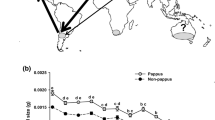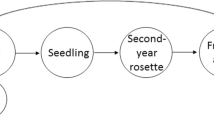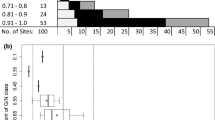Abstract
An assumption of weed science and conservation biology is that small populations are more vulnerable to elimination and extinction than large populations. We tested this with the invasive biennial garlic mustard (Alliaria petiolata). We compared 61 experimental populations from which every flowering plant was removed for 4 years, with 56 control populations. Whereas the majority of the control populations continued to expand in size over the 4 years, experimental populations showed a strong experimental effect, remaining stable in size, declining in size, or going extinct. Small populations were far more vulnerable to extinction than large populations: 43% of small experimental populations (initially fewer than 10 individuals) went extinct, but only 7% of large populations (initially more than 50 individuals). However, some small experimental populations persisted, and in a few cases, larger experimental populations continued to expand even though every flowering individual had been removed. These results and a simple population model suggest the importance of buried seeds in allowing this species to persist despite attempts to eradicate it.
Similar content being viewed by others
References
Anderson RC, Dhillion SS and Kelley TM (1996) Aspects of the ecology of an invasive plant, garlic mustard (Alliaria petiolata), in Central Illinois. Restoration Ecology 4: 181–191
Baskin JM and Baskin CC (1992) Seed germination biology of the weedy biennial Alliaria petiolata. Natural Areas Journal 12: 191–197
Baskin CC and JM Baskin (1998) Seeds: Ecology, Biogeography, and Evolution of Dormancy and Germination. Academic Press, Boston, Massachusetts
Berger J (1990) Persistence of different-sized populations: an empirical assessment of rapid extinctions in big-horn sheep. Conservation Biology 4: 91–98
Caswell H (1989) Matrix Population Models. Sinauer Association, Sunderland, Massachusetts
Cavers PB, Heagy MI and Kokron RF (1979) The biology of Canadian weeds.35. Alliaria petiolata (M. Bieb.) Cavara and Grande. Canadian Journal of Plant Science 59: 217–229
Cousens R and Mortimer M (1995) Dynamics of Weed Populations, Cambridge University Press, Cambridge, Massachusetts
Cruden RW, McClain AM and Shrivastava GP (1996) Pollination biology and breeding system of Alliaria petiolata (Brassicaceae). Bulletin of the Torrey Botanical Club 123(4): 273–280
Drayton B (1999) Experimental ecology of plant reintroductions. PhD dissertation. Boston University, Boston, Massachusetts
Drayton B and Primack RB (1996) Plant species lost in an isolated conservation area in metropolitan Boston from 1894 to 1993. Conservation Biology 10: 30–39
Hanski IA (1991) Single-species metapopulation dynamics: concepts, models, and observations. In: Gilpin M and Hanski I (eds) Metapopulation Dynamics: Empirical and Theoretical Investigations, pp 17–38. Academic Press, San Diego, California
Hanski IA and Gilpin ME (1997) Metapopulation Biology: Ecology, Genetics, and Evolution. Academic Press, New York
Harper JL (1977) Population Biology of Plants. Academic Press, Boston, Massachusetts
Husband BC and Barrett SCH (1996) A metapopulation perspective in plant population biology. Journal of Ecology 84(3): 461–470
Jones HL and Diamond JM (1976) Short-time-base studies of turnover in breeding birds of the California Channel Islands. Condor 76: 526–549
Kelly D (1985) On strict and facultative biennials. Oecologia 67: 292–294
Moody ME and Mack RN (1988) Controlling the spread of plant invasions: the importance of nascent foci. Journal of Applied Ecology 25: 1009–1021
Nuzzo VA (1991) Experimental control of garlic mustard (Alliaria petiolata [M. Bieb.] Cavara and Grande) in northern Illinois using fire, herbicide, and cutting. Natural Areas Journal 11: 158–167
Nuzzo, VA (1993a) Current and historic distribution of garlic mustard (Alliaria petiolata) in Illinois. Michigan Botanist: 23–33
Nuzzo VA (1993b) Distribution and spread of the invasive biennial Alliaria petiolata (garlic mustard) in North America. In: McKnight B (ed) Biological Pollution: The Control and Impact of Invasive Exotic Species, pp 137–146. Indiana Academy of Science, Indianapolis, Indiana
Nuzzo VA (1996) Fire impact on groundlayer flora in a sand forest 1990–1994. American Midland Naturalist 136(2): 207–221
Primack RB (1996) Lessons from ecological theory: dispersal, establishment, and population structure. In: Falk DA, Millar CI, and Olwell M (eds) Restoring Diversity: Strategies for Reintroduction of Endangered Plants, pp 209–234. Island Press, Washington, DC
Thompson K and Grime JP (1979) Seasonal variation in the seed banks of herbaceous species in ten contrasting habitats. Journal of Ecology 67: 893–921
Author information
Authors and Affiliations
Rights and permissions
About this article
Cite this article
Drayton, B., Primack, R.B. Experimental Extinction of Garlic Mustard (Alliaria petiolata) Populations: Implications for Weed Science and Conservation Biology. Biological Invasions 1, 159–167 (1999). https://doi.org/10.1023/A:1010017510471
Issue Date:
DOI: https://doi.org/10.1023/A:1010017510471




